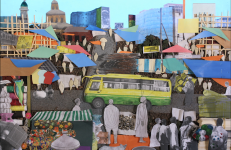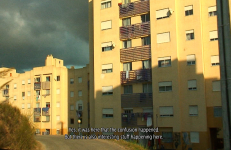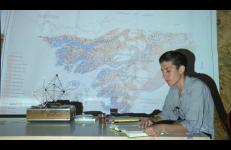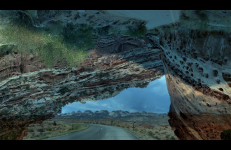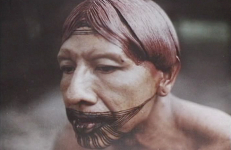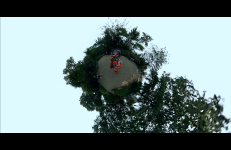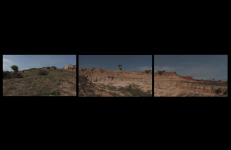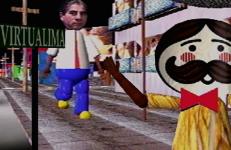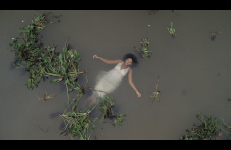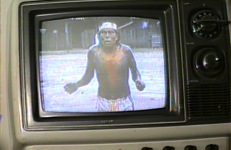Combining collage and animation with an Asian-influenced soundtrack, images of women dancing sensually and devotional imagery, Matsushima Ondo compares religious devotion with sexual representation. The viewer is invited to make connections and recognize the irony in some of the similarities.
Post-colonialism
In this video, the artist tries to overcome the effects of distance, and reflects on geography represented in exile due to war, and on the psychological distance represented in each one’s approach to her womanhood. The video beautifully weaves personal images and audio recordings of a very intimate nature, binding the personal with the political.
Chief Waiwai recounts for his village the story of a trip he and a small entourage made to meet the Zo’é, a recently contacted group whom the Waiãpi “know” through video. Both groups speak Tupi dialects and share many cultural traditions, but the Zo’é are currently experiencing the phenomena of contact that the Waiãpi underwent 20 years ago. Waiãpi cameraman Kasiripinã illustrates the Waiwai’s account of the trip with video. The Zo’é afford their visitors the chance to re-encounter the way of life and wisdom of their ancestors.
Chief Waiwai recounts for his village the story of a trip he and a small entourage made to meet the Zo’é, a recently contacted group whom the Waiãpi “know” through video. Both groups speak Tupi dialects and share many cultural traditions, but the Zo’é are currently experiencing the phenomena of contact that the Waiãpi underwent 20 years ago. Waiãpi cameraman Kasiripinã illustrates the Waiwai’s account of the trip with video. The Zo’é afford their visitors the chance to re-encounter the way of life and wisdom of their ancestors.
Tanaka passionately evokes the loss of her mother by visually recreating the ominous and disempowering feeling of isolation that accompanies mourning. The tape enunciates the painful phases of grieving: the claustrophobic results of dealing with the inevitability of death, the transitional void where one is lost between the comfortable orientation of one’s world and Nothing, and the new sense of clarity where images from the past resurface from the abyss of forgetfulness.
Based on Emanuel Admassu's essay Menged Merkato, an architectural analysis and historical journey of the largest open-air market in Africa, located in Addis Ababa, Ethiopia. Merkato was developed during the Italian occupation of Addis Ababa to segregate the markets of the locals and the newcomers. Unlike the earlier circular formation which centered the royal palace, Merkato was built on a grid which allowed for a dispersed flow facilitating dynamic interactions and exchanges.
Military Road is a project of visual mapping of the suburban realities of the city of Lisbon in connection to the migrant fluxes to Europe conected to de-colonization and the end of the Portuguese Empire in Africa. Military road was built around the city at the beginning of the XIX century, to defend the city from the French and English invasions.
The film-essay Mined Soil revisits the work of the Guinean agronomist Amílcar Cabral, who studied soil erosion in the Alentejo region of Portugal through the lens of his political engagement as a leader of the African Liberation Movement of the 1950s. This line of thought intertwines with documentation of an experimental gold mining site, now operated by a Canadian company located in the same Portuguese region once studied by Cabral.
“Hopinka’s video Mnemonics of Shape and Reason (2021) traverses the memory of a place and space visited by the artist. Employing an original syntax of storytelling, the artist interweaves scattered and reassembled landscapes with layers of captured audio, poetic text, and music. A rhythmic account of the spiritual implications of colonial plunder, Hopinka’s fluid reflections transmute ideas of spiritual malleability tied to land, sky, sea, myth, place, and personhood.”
Commissioned by ICA Miami.
Morayngava: the “design of things.” Yngiru: the box of the spirits, the films, just like xaman dreams. This is how the Asurini define video, which has just arrived in their village. After discovering that it is possible to store their images, the old men lament that they never stored images of their ancestors and decided to register the initiation of a xaman, a tradition threatened by new times.
Directed by Virginia Valadão and Regina Müller.
In Assurini with English subtitles.
Morayngava: the “design of things.” Yngiru: the box of the spirits, the films, just like xaman dreams. This is how the Asurini define video, which has just arrived in their village. After discovering that it is possible to store their images, the old men lament that they never stored images of their ancestors and decided to register the initiation of a xaman, a tradition threatened by new times.
Directed by Virginia Valadão and Regina Müller.
In Assurini with English subtitles.
In the case of Carlos Motta’s career, the impetus has always been on, not adhering to particular medium or a particular style, but rather using media as it becomes appropriate tell a story that has heretofore been stifled by dominant power structures. The technical variability of his work is only matched by its potential to generate conversation and discourse in the arenas of sexuality, gender, democracy and colonialism – usually as a conflux of all four through historical excavation.
In this classic personal elegy, Kubota mourns her father's death and recounts the last days of his life. Reflecting on Kubota's use of the video medium, the television emerges as the link between Kubota and her father, with the melodramatic crooning of Japanese pop singers providing a backdrop for Kubota's real-life tragedy.
This title is also available on Surveying the First Decade: Volume 1.
My Mother’s Place is an experimental documentary focusing on the artist’s mother, a third-generation Chinese-Trinidadian who at 80 still has vivid memories of a history lost or quickly disappearing. She conveys these with a storytelling style and a frankness that is distinctly West Indian. A tape about memory, oral history, and autobiography, My Mother’s Place interweaves interviews, personal narrative, home movies, and verité footage of the Caribbean to explore the formation of race, class, and gender under colonialism.
This promotional initiation video lures inductees with promises of decolonization and settler remediation. Imagery of settler-led planetary destruction is juxtaposed with sequences of underground group therapy sessions where settlers can lose, forget, and explore their identities in order to indigenize. Sharing their labor, lurking through museums, and institutions, future accomplices snap thousands of cellphone pictures of every artifact and artwork on hand.
NOMADS at the 25 DOOR is presented in three chapters and based around a series of interviews between Finley and Mickey Yates, a 22-year-old woman serving a double life sentence in the Nevada Women’s Correctional Institution for the murder of her mother. Interweaving interview excerpts with footage of the upheaval in Eastern Europe, the tape explores the memory’s construction of an ephemeral homeland when a concrete one is lost, stolen or left behind.
Spanning 500 years of colonial destruction, Nosferasta tells the story of Oba, a Rastafarian vampire, and Christopher Columbus, Oba’s original biter, as they spread the colonial infection throughout the “new world.” Formally a vampire film and series of installations, the stylistically impressionistic Nosferasta examines the guilt of being complicit in imperial conquest, while also acknowledging the difficulty of unlearning centuries of vampiric conditioning. At its core Nosferasta asks, how can you decolonize what’s in your blood?
Spanning 500 years of colonial destruction, Nosferasta tells the story of Oba, a Rastafarian vampire, and Christopher Columbus, Oba’s original biter, as they spread the colonial infection throughout the “new world.” Formally a vampire film and series of installations, the stylistically impressionistic Nosferasta examines the guilt of being complicit in imperial conquest, while also acknowledging the difficulty of unlearning centuries of vampiric conditioning. At its core Nosferasta asks, how can you decolonize what’s in your blood?
Notes for a DejaVu is a paramnesic experience of the images where Jonas Mekas still lives and we can hear him comment on the memory of an imaginary trip to Mexico. This film is shot with an expired 16mm celluloid during a popular protest. This is a movie that remembers. This is a political movie.
Once Upon a Time is about these encounters of diaspora and the displaced ‘homeland’ and describes a personal tale of my own diaspora and traveling culture, which crosses the boundaries of nation-states and is located in between different geographical places. Through this film work I explore a historical interpretation of the term ‘diaspora’ but also try to further explore and conceive the term in relation to more recent forms of migration and transcultural experience.
Oued Nefifik: A Foreign Movie is an experimental narrative that incorporates an actual political situation. The film was shot in the immediate aftermath of violent repression following food riots in Casablanca, June 1981. It characterizes the experience of a political event for people outside of it. The point of view is that of an absurd and sympathetic character based on Jacques Tati’s Mr Hulot, who is distanced from the post-colonial milieu in which he finds himself.
This video proposes an ironic metaphor to grasp the follies of U.S. government action and inaction in Central America. The process of learning U.S. policy is similar to the process of a young child acquiring the principles of language. These dual senses of literacy operate on several levels, situating a child’s consciousness within the contradictions of history comments on the illusory innocence of childhood, and the unexamined, but real, guilt of the U.S. government, its supporters and clients.
An experimental video about immigration. Looking at the potato (which was first cultivated in Peru) Papapapá paints a picture of a vegetable that has traveled and been transformed—following the migrating potato North where it becomes the potato chip, the couch potato, and the french fry. Papapapá simultaneously follows another Peruvian in motion, the artist’s father, Augusto Rivera. The stories of the two immigrants, the potato and Papa Rivera, converge as Augusto becomes a Peruvian couch potato, sitting on an American sofa, eating potato chips and watching Spanish language television.
Path to the Stars follows the journey of a heroine confronted by her own shadow, by different temporalities and micro-narratives. It proposes a counter-narrative composed of complex biographies that overlap and interact: from the anticolonial freedom fighters of the past, and the uncertainty of the present, the desire to belong, to the projection of a future where our symbiosis with nature is recuperated.
Pemp traces the 25-year struggle of the Parakatêjê (Gavião) to maintain autonomy in the face of huge development projects in the south of Pará. From the initial recovery of their lands in 1957 through dealings with FUNAI in the 1970s and the appropriation of Brazil nut monopolies to their current negotiations with the government, Pemp shows the Parakatêjê’s most precious project; the preservation of their ceremonies and songs. The Kokrenum, chief and keeper of the group’s traditions, uses video to transmit them to future generations.








